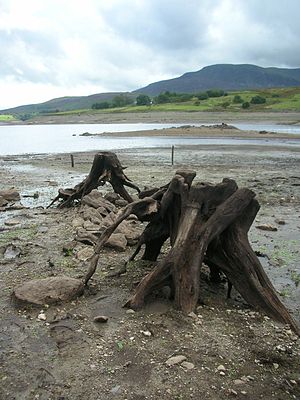Capel Celyn
Capel Celyn was a rural community to the north west of Bala in Merionethshire, in the River Tryweryn valley. The village and other parts of the valley were flooded in the 1960s to create a reservoir, Llyn Celyn, to supply Liverpool and the Wirral with water for industry. The village contained, among other things, a chapel, as the name of the community suggests, capel being Welsh for 'chapel'.
Contents
History
In 1956, a private bill sponsored by Liverpool City Council was brought before Parliament to develop a water reservoir from the Tryweryn Valley. The development would include the flooding of Capel Celyn. The unimpeachable authority of an Act of Parliament, with which local authorities could not interfere, and the fact that the village was one of the last communities speaking Welsh only, ensured that the proposals became deeply controversial. Thirty-five out of thirty-six Welsh Members of Parliament opposed the bill while the other did not vote, but in 1957 it was passed. The members of the community waged an eight-year effort, ultimately unsuccessful, to prevent the destruction of their homes.
When the valley was flooded in 1965, the village and its buildings, including the post office, the school, and a chapel with cemetery, were all lost. Twelve houses and farms were submerged, and 48 people of the 67 who lived in the valley lost their homes.[1] In all some 800 acres of land were submerged. Llyn Celyn, otherwise known as the Tryweryn Reservoir, was formed. Many of the stones from the original chapel were re-used in the construction of the new Memorial Chapel.
The water in the reservoir is used to maintain the flow of the River Dee so that water may be abstracted downstream,[2] and additionally to improve the quality of white-water sports on Afon Tryweryn.
A full list of the submerged properties (from largely west to east) is as follows -
| Moelfryn | Gwerndelwau |
| Glan Celyn + y Llythyrdy (Post Office) | Y Capel (Chapel) |
| Y Fynwent (Cemetery) | Tŷ Capel (Chapel House) |
| Tynybont | Yr Ysgol (School) |
| Brynhyfryd | Y Gelli |
| Cae Fadog | Penbryn Fawr |
| Coed Mynach | Dol Fawr |
| Garnedd Lwyd | Hafod Fadog (Quaker meeting place) + Mynwent y Crynwyr (The Quakers' Cemetery) |
| Y Tyrpeg (The Turnpike) | Tyddyn Bychan |
Families who had relatives buried in the cemetery were given the option of either moving them to another cemetery, or leaving them. Consequently, eight bodies were disinterred, and the remainder left. All headstones were removed, and the cemetery was then covered in a layer of gravel, then concrete.[1]
Hafod Fadog
One of the farmsteads covered was Hafod Fadog, a Quaker meeting place. It is recorded on a bronze plaque in a lay-by near to the dam:Under these waters and near this stone stood Hafod Fadog, a farmstead where in the seventeenth and eighteenth centuries Quakers met for worship. On the hillside above the house was a space encircled by a low stone wall where larger meetings were held, and beyond the house was a small burial ground. From this valley came many of the early Quakers who emigrated to Pennsylvania.
Political effects
The building of the reservoir was instrumental in an increase in support for the Welsh nationalist party, Plaid Cymru, during the late 1950s. Almost unanimous Welsh political opposition had failed to stop approval of the scheme, a fact that Plaid Cymru exploited;[3] at the subsequent General Election the party's support increased from 3.1% to 5.2%.
Of perhaps greater significance, however, was the impetus the episode gave to passing paowers to more local authority, and ultimately to the creation of a Welsh Office and Secretary of State for Wales in 1964.[4] In October 1965 the Llyn Celyn reservoir opened in the face of a sizeable demonstration. On 19 October 2005, Liverpool City Council issued a formal apology for the insensitivity displayed iin the matter.[5]
Popular culture
The flooding of the village inspired a Manic Street Preachers song, "Ready For Drowning" [6] and Enya's song "Dan y Dŵr".[7]
Outside links
- Location map: 52°57’11"N, 3°42’50"W
- Picture gallery
- Photos of the protest at BBC Liverpool
- National Library of Wales page on Tryweryn
- Capel Celyn and other Welsh communities flooded to create reservoirs
References
- ↑ 1.0 1.1 Capel Celyn, Ten Years of Destruction: 1955 - 1965, by Einion Thomas, published by Cyhoeddiadau Barddas & Gwynedd Council, 2007, ISBN 978-1-900437-92-9
- ↑ "Core Management Plan including Conservation Objectives for River Dee and Bala Lake / Afon Dyfrdwy a Llyn Tegid SAC". Countryside Council for Wales. 15 April 2008. http://www.ccgc.gov.uk/landscape__wildlife/protecting_our_landscape/special_sites_project/river_to_usk_sac_list/idoc.ashx?docid=601bc11b-69fc-4418-9235-5cb2fdcfed9c&version=-1. Retrieved 5 February 2013.
- ↑ Davies, J, A History of Wales, (1990, rev. 2007), Penguin
- ↑ Butt-Phillip, A, The Welsh Question, (1975), University of Wales Press
- ↑ "Official apology over Tryweryn", BBC News, 19 October 2005.
- ↑ http://www.thisisyesterday.com/ints/selectnov98.html Interview, Select Magazine, November 1998
- ↑ "Liner notes from The Celts album", Roma Ryan, 1993.
